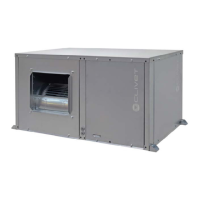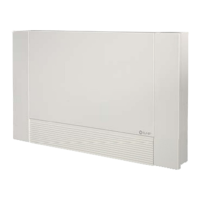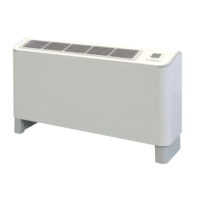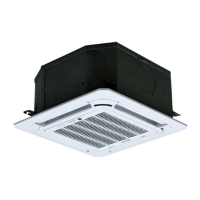48
EVH-X SPACE 2.1 - 12.1
M0SM10N17-03
10 MAINTENANCE
General
Maintenance must be done by authorized centres
or by qualified personnel.
The maintenance enables:
• maintain the unit efficiency;
• reduce the deterioration speed to whom every
equipment is subject over time;
• assemble information and data to understand
the state of the unit efficiency and avoid
possible damages.
Inspections frequency
The inspections should be carried out at least:
• Every year for only the cooling units
• Every six months for the cooling and heating
units
The frequency, however, depends on the use.
In the event of frequent use it is recommended to
plan inspections at close intervals:
• frequent use (continuous or very intermittent
use, near the operating limits, etc)
• critical use (service necessary).
Machine blooklet
It’s advisable to create a machine booklet to take
notes of the unit interventions.
In this way it will be easier to adequately note the
various interventions and aid any troubleshooting.
Report on the booklet:
• data
• intervention description
• carried out measures etc..
Put at reset
If a long period of inactivity is foreseen:
• Turn of the power
• avoid the risk of frost (evacuate the system or
add glycol)
Turn off the power in order to avoid electrical risks
or damages by lightning strikes
With lower temperatures keep heaters turned on in
of the electrical panel (option).
It’s recommended that the starter after the period
of detention is made by a qualified technician,
especially after seasonal stops or seasonal switch.
When restarting, refer to that indicated in the
START-UP section .
Schedule technical assistance in advance to avoid
hitches and to guarantee that the system can be
used when required.
Water exchanger
It is very important for the exchanger to be able to
provide the maximum thermal exchange. Therefore,
it is essential for the inner surfaces to be clean of
dirt and incrustations.
Periodically check the difference between the
temperature of the supply water and the
condensation temperature. If the difference is
greater than 8 °C – 10 ° C it is advisable to clean
the exchanger.
The clearing must be effected:
• With circulation opposite to the usual one
• With a speed at least 1,5 times higher than the
nominal one
• With an appropriate product moderately acid
(95% water + 5% phosphoric acid
• after cleaning rinse with water to avoid any
detergent residues
Water filter
Verify that there are no impurities that obstruct the
smooth passage of water.
Condensate discharge
Dirt or scale could cause blockages.
Also in the drain pain can proliferate
microorganisms and mold.
To provide for a periodic cleaning with appropriate
detergents and in case a disinfection with sanitizing
products.
When the clearing is finished, put some water in
the drain pain to check the regular down flow.
Air filter
Cleaning and replacement of filters are very
important in terms of health and hygiene.
How often the filters need to be checked depends
on the quality of outdoor air, unit operating hours,
dust and number of persons in the rooms.
Approximately, cleaning should ideally take place
between weekly and monthly. It is advisable to start
with frequent checks, and to adjust the frequency
based on how much dirt is discovered.
Change the PC18 Filter alarm parameter if
necessary (page 46)
Therefore, the unit must always operate with the
filters installed and clean.
Operation with clogged filters leads to a
reduction in the air flow rate, resulting in
malfunctions and unit shutdowns. It may even
cause the unit to break down

